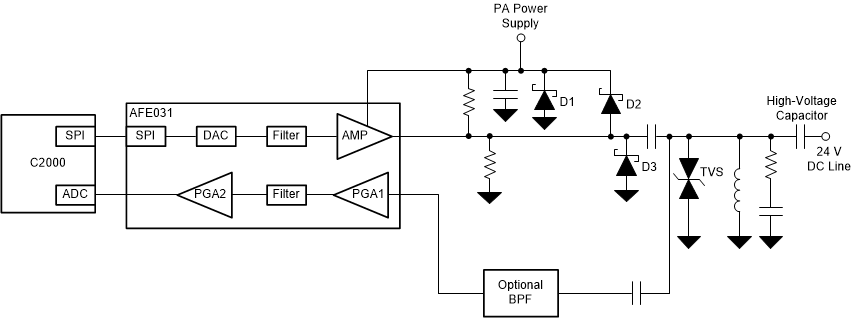SPRAC94D September 2018 – March 2022 AFE030 , AFE031 , TMS320F28075 , TMS320F28075-Q1 , TMS320F28076 , TMS320F28374D , TMS320F28374S , TMS320F28375D , TMS320F28375S , TMS320F28375S-Q1 , TMS320F28376D , TMS320F28376S , TMS320F28377D , TMS320F28377D-EP , TMS320F28377D-Q1 , TMS320F28377S , TMS320F28377S-Q1 , TMS320F28379D , TMS320F28379D-Q1 , TMS320F28379S
- Trademarks
- 1 FSK Overview
- 2 Hardware Overview
- 3 Interfacing With the AFE03x
- 4 Transmit Path
- 5 Receive Path
- 6 Interfacing With a Power Line
- 7 Summary
- 8 References
- 9 Schematics
- 10Revision History
6.3 Coupling to DC Line
Coupling to a dc line has similar components for protection with the lack of components such as HV inductor, MOV, and the transformer. Figure 6-2 shows what is needed for coupling circuit and transient protection.
 Figure 6-2 Coupling Circuit for a DC
Line
Figure 6-2 Coupling Circuit for a DC
LineA 10 µF capacitor was used to couple to the dc line. When coupling to a dc line it is important to remember that line is generally low impedance and may affect the output swing of the PA in the AFE031. Connecting an inductor in series with the line wikk provided enough impedance to the power line communications signal such that the power supply (possibly very low impedance) does not interfere with the PLC signal modulation. Figure 6-3 shows PLC modules coupled to a low-impedance dc line.
 Figure 6-3 Example of Multiple PLC
Modules Coupled to a DC Line
Figure 6-3 Example of Multiple PLC
Modules Coupled to a DC LineFor detailed test data on this circuit, see the DC Power-Line Communication Reference Design.